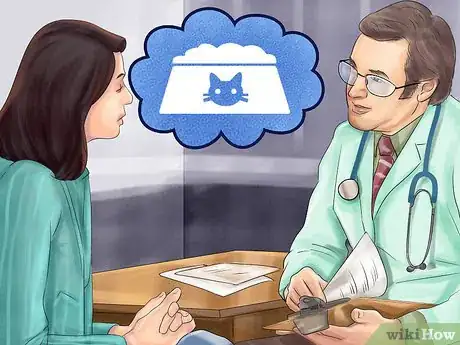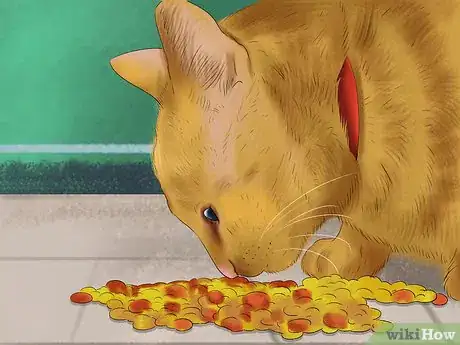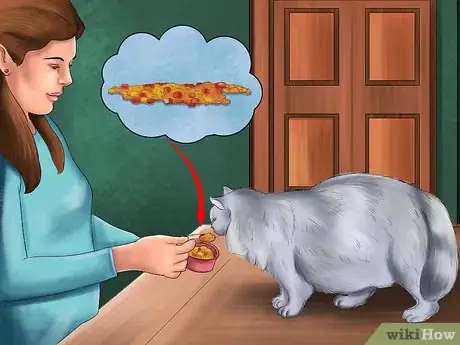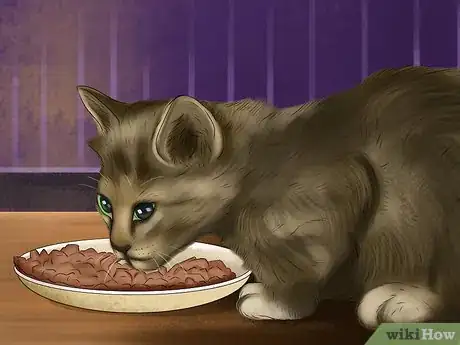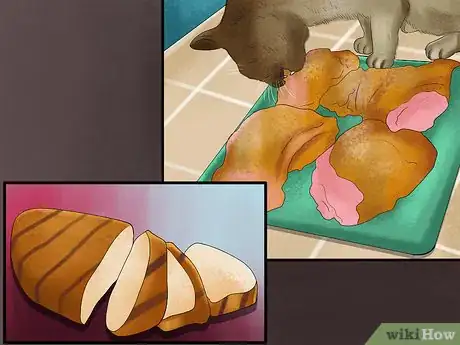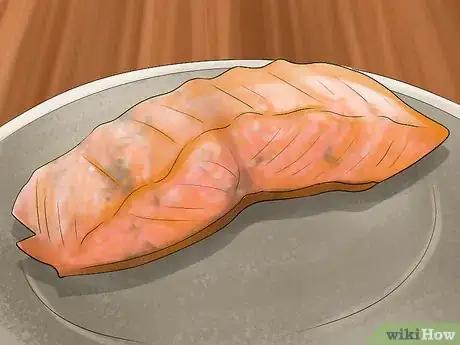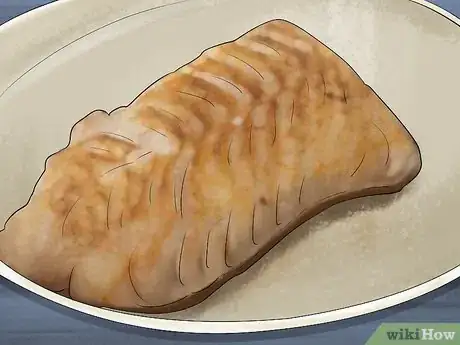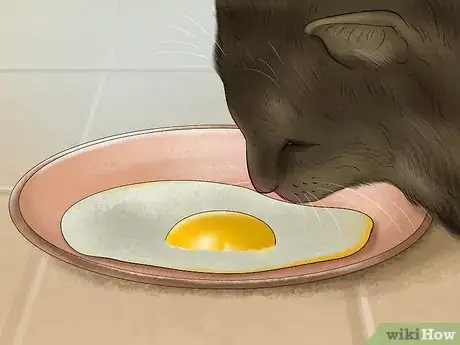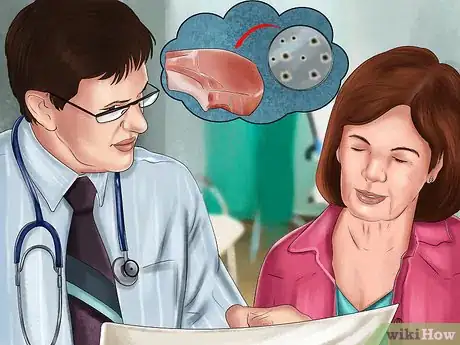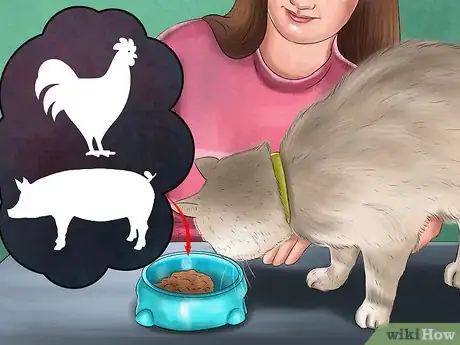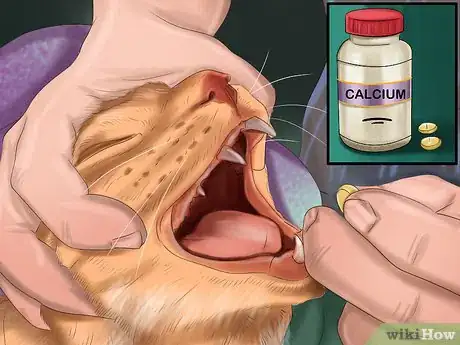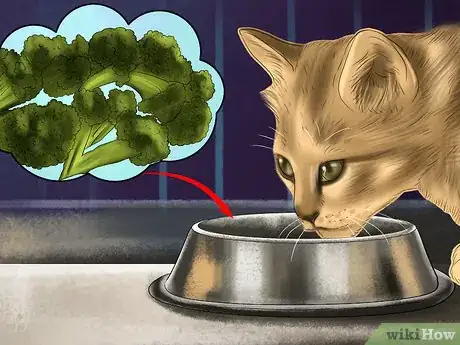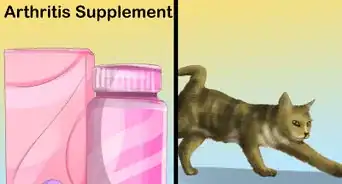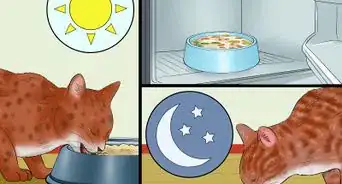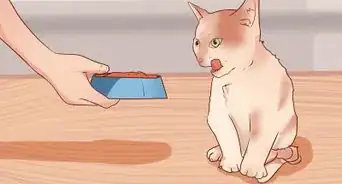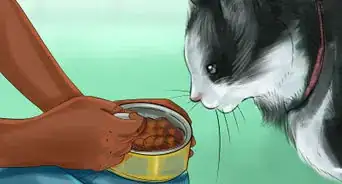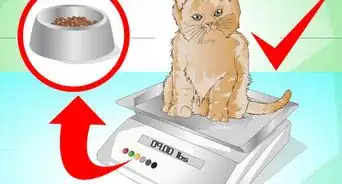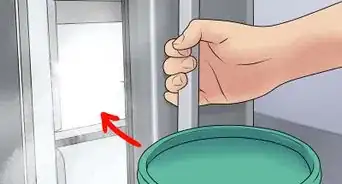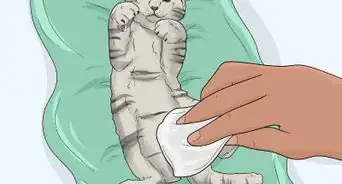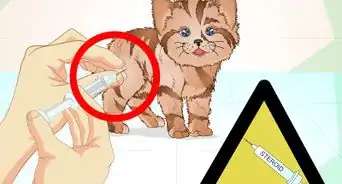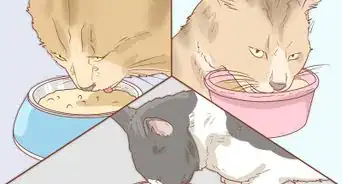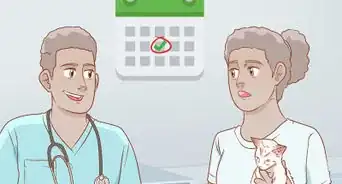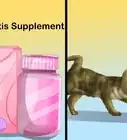This article was co-authored by wikiHow Staff. Our trained team of editors and researchers validate articles for accuracy and comprehensiveness. wikiHow's Content Management Team carefully monitors the work from our editorial staff to ensure that each article is backed by trusted research and meets our high quality standards.
There are 9 references cited in this article, which can be found at the bottom of the page.
This article has been viewed 15,121 times.
Learn more...
Cats, as a species, are obligate carnivores. This means that their diet should comprise mostly meat. However, the most common cat foods are high in carbohydrates and plant proteins, and undergo heavy amounts of processing. If you’d like to stop serving your cat processed food and convert them to a natural diet, begin by transitioning them to a wet food. Then, you can add healthy natural foods to their meals, and even convert the cat to a raw diet, with the assistance of a veterinary specialist.
Steps
Transitioning Your Cat to Wet Food
-
1Consult your veterinarian about changing your cat’s diet. Your cat’s dietary nutrition is important, and the animal’s health could be damaged if you make an ill-advised change to their diet. Schedule an appointment with your vet, and ask their advice about the feline diet.
- See if the vet recommends providing your cat with a natural (or raw) diet, and ask which specific foods—and in what quantities—they suggest feeding your cat.
-
2Avoid serving your cat dry food. Although the majority of commercial cat foods are made of dried kibble, these actually contain relatively little nutritional value for cats. Dried kibble has next to no water content, gives cats an excessive amount of carbohydrates, and often contains plant-based proteins rather than the animal-based proteins that cats need to stay healthy.[1]
- Dry kibble is also heavily processed and contains few natural ingredients. If you’d like to give your cat natural foods, the first step is to switch them to a wet food.
Advertisement -
3Introduce your cat to wet food. If your cat has been eating only dry kibble, now is the time to switch them to a wet food. Do not leave wet food sitting out all day for your cat; feed them at two or three daily meal times. If the cat does not eat the wet food within 30 minutes, pick the food back up. To ease the transition, you can start by mixing in a moderate amount of dry food with the wet food, and then slowly phasing out the kibble.[2]
- You can find a high-quality wet food for purchase at your local pet-supply store. Speak with the staff or owner, and ask their recommendations for a wet cat food.
- Also read the nutrition label on a few different brands of wet food. Select the option that provides high protein, low carbohydrates, and plenty of vitamins. If possible, select a low-grain wet food.
-
4Feed your cat wet cat food. A high-quality canned cat food will contain healthy proteins and nutrients for your cat. While wet canned food undergoes some degree of processing, it’s much less than high amounts of processing done to dried kibble. Wet food is also low in carbohydrates, which will benefit your cat’s nutrition. A cat’s diet should be very low in carbs, with carbs composing only 1–2% of the whole diet.[3]
- Cats living in nature get a large percentage of their water from the food they eat, since animal flesh has a high water content. Serving your cat a high-quality wet food can provide cats with a natural means of staying hydrated.
Feeding Your Cat Non-Processed Foods
-
1Feed your cat cooked poultry. Were they living in the wild, animal meats would be the staple of cats’ diets, and they are one of the best natural foods that you can serve your cat. Cats will eat nearly all types of meat, including beef and pork. However, cooked poultry (chicken or turkey) is best for your cat.[4]
- When you first serve your cat cooked poultry, give it a small to moderate amount of meat, in case it doesn’t like the flavor. Start by giving your cat about ¼ cup (2 ounces) of meat.
- Avoid giving your cat meat with a lot of fatty tissue. Although cats will eat the fat, it provides them with little protein and gives no dietary benefits. Too much fat with a single meal can also give your cat diarrhea.
-
2Give your cat small pieces of cooked salmon. Salmon is rich in healthy fats and protein, and will make a healthy complement to your cat’s diet. Sprinkle a small handful of salmon on top of your cat’s food at dinnertime. [5]
- Salmon is often found in wet commercial cat foods, so if you give your cat extra salmon, you’ll simply be increasing the amount of a protein they’re already receiving.
-
3Feed your cat cooked cod or flounder. Both of these fish are healthy for cats to eat, and will not carry high levels of mercury, which carnivorous fish like tuna or swordfish have been known to carry. Most types of fish are high in nutrients and will give your cat proteins and vitamins that they need to stay healthy.[6]
- Make sure to only feed your cat cooked fish, as raw fish can carry illnesses. For example, raw freshwater fish may contain tapeworm eggs, and raw oily fish contain thiaminase, which breaks down thiamine, a vitamin that your cat’s body needs.
- As with the salmon, you can sprinkle a small handful of cooked cod or flounder on top of your cat’s food with their dinner.
-
4Serve your cat occasional eggs. Eggs can function as a high-protein dietary supplement for house cats. Cats will likely scarf down any eggs that you set in front of them, but should only be served fully-cooked eggs. Prepare eggs by hard boiling or scrambling them.[7] Avoid giving cats raw eggs, or eggs that are partially raw. This includes soft-boiled, fried, or poached eggs.
- Although eggs are primarily thought of as a food for human consumption, they are high in protein and would constitute part of a cat’s natural diet, were it living in the wild.
Switching Your Cat to a Raw Diet
-
1Confer with your veterinarian. Although the number of cat-owners who advocate serving your cat a raw diet is growing, there are certain concerns that you should discuss with a vet or an animal nutritionist. Although raw foods are the most natural, there are always associated health risks.[8] For example, raw meats may be contaminated with bacteria, or may carry parasites.
- Additionally, it can be difficult to put together the right raw diet for your cat. Cats have specific nutritional needs, and without the help of a veterinarian, it will be challenging to assemble a nutritionally complete raw diet for your cat.
-
2Serve your cat a variety of raw meats. Cats are notoriously picky eaters, and will be as particular about their raw food as they would be about any other type of food. Purchase commercially prepared raw meat at your local grocery store: start with common types like poultry, beef, and pork. Some cats may also prefer game meats, such as pheasant, quail, and rabbit.[9]
- Before serving, cut the meat into smaller pieces that your cat can chew without much difficulty. Aim for pieces that are about a cubic inch (2.3 cubic centimeters).
- Give the raw food to your cats at two or three specific mealtimes during the day. Avoid letting the raw food sit out for more than 30 minutes, as it may accumulate bacteria or begin to spoil.
-
3Provide your cat with calcium supplements. While the majority of nutrition that a cat needs will come directly from the meat, it’s also important that cats have calcium in their diet. You can purchase a calcium supplement at your local pet-supply store or health-food store. Consult the nutrition label or speak with your veterinarian to determine how much daily calcium your cat needs.[10]
- Some more ambitious raw-food enthusiasts will purchase beef or pork with the bone still in, and then grind the bone itself to supplement the cat’s diet.
- Do not serve your cat cow’s milk. Cats are lactose intolerant, and cow milk can be harmful to their digestive system.
-
4Supplement your cat’s raw diet with occasional vegetables. Since cats are obligate carnivores, they need a meat-based diet, but can have other occasional additions. For example, since meat is low in fiber, cats can benefit from occasional servings of a vegetable, in order to provide roughage and keep their digestive system working well.[11]
- Occasionally serve your cat steamed broccoli or carrots, in addition to their raw food, at regular meal times. Although you can try mixing a vegetable in with your cat’s meat, they may be more inclined to eat the broccoli or carrots if you place them in a separate dish.
Community Q&A
-
QuestionMy cat hunts birds, mice, squirrels and other critters everyday, and she eats them. We give her raw chicken liver, thighs and gizzards, as well as good-quality pet-store food. Is this a balanced diet?
 Community AnswerAlthough cats are built to eat small animals, you should consult with a vet to understand how your cat's hunting habit fits into her diet as a whole.
Community AnswerAlthough cats are built to eat small animals, you should consult with a vet to understand how your cat's hunting habit fits into her diet as a whole. -
QuestionDoes this mean I can feed my cat wet food?
 Merlin77Top AnswererYes, feeding wet food is just fine. It is much better than kibble, in terms of biological appropriateness. If you are on a budget and buy dry food, you should also include a meal of wet food at least three-four times a week.
Merlin77Top AnswererYes, feeding wet food is just fine. It is much better than kibble, in terms of biological appropriateness. If you are on a budget and buy dry food, you should also include a meal of wet food at least three-four times a week. -
QuestionCats don’t cook food in nature. Why should I cook their food?
 Iris8989Community AnswerThese are domesticated cats. Wild cats like lions, tigers, and bobcats have lived in the wild for generations already. Domesticated cats have been bred over thousands of years to be suitable for humans to keep as pets. Domesticated cats still keep their cat-like traits (like hunting for prey and hissing at unfriendly things), but they cannot eat raw food, since their stomachs no longer process the bacteria in it. The bacteria in raw food can make them sick. Wild cats can process the bacteria, but domesticated cats cannot. Just as humans can't eat too much raw meat, domesticated cats cannot either.
Iris8989Community AnswerThese are domesticated cats. Wild cats like lions, tigers, and bobcats have lived in the wild for generations already. Domesticated cats have been bred over thousands of years to be suitable for humans to keep as pets. Domesticated cats still keep their cat-like traits (like hunting for prey and hissing at unfriendly things), but they cannot eat raw food, since their stomachs no longer process the bacteria in it. The bacteria in raw food can make them sick. Wild cats can process the bacteria, but domesticated cats cannot. Just as humans can't eat too much raw meat, domesticated cats cannot either.
References
- ↑ http://www.animalplanet.com/pets/1-meat/
- ↑ http://feline-nutrition.org/nutrition/how-to-transition-your-cat-to-a-raw-diet
- ↑ http://catinfo.org/
- ↑ http://www.animalplanet.com/pets/1-meat/
- ↑ http://www.pawculture.com/pet-wellness/nutrition/15-human-foods-that-are-safe-for-cats/#2
- ↑ http://www.animalplanet.com/pets/3-fish/
- ↑ http://www.animalplanet.com/pets/2-eggs/
- ↑ http://pets.webmd.com/cats/guide/homemade-cat-food-and-raw-cat-food#2
- ↑ http://feline-nutrition.org/nutrition/how-to-transition-your-cat-to-a-raw-diet
About This Article
If you want to feed your cat a natural diet of wet food, talk to your veterinarian first for their thoughts on which foods to use and which to avoid. Slowly begin introducing your cat to the wet food by mixing it with kibble at first, then phasing out the kibble over time. Make sure to collect the bowl 30 minutes after setting it down, so the wet food doesn't sit out for too long, and repeat this process 2 to 3 times daily, so your cat gets enough to eat. If you want to feed your cat non-processed foods, see if it has interest in eating eggs or a little lean meat from cooked poultry, cooked salmon, or cooked cod or flounder. For more tips, like how to switch your cat to a raw diet, keep reading!
